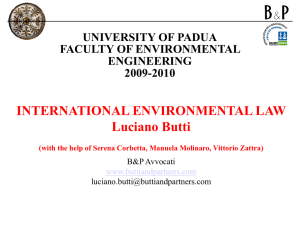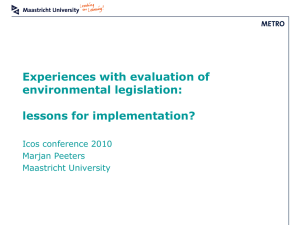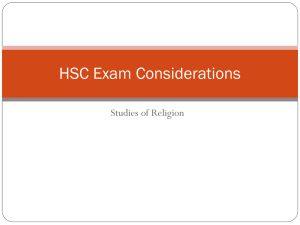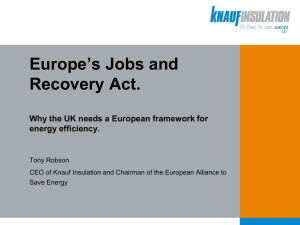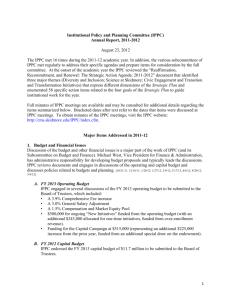Screening Regulatory Impact Analysis – Industrial Emissions Directive
advertisement
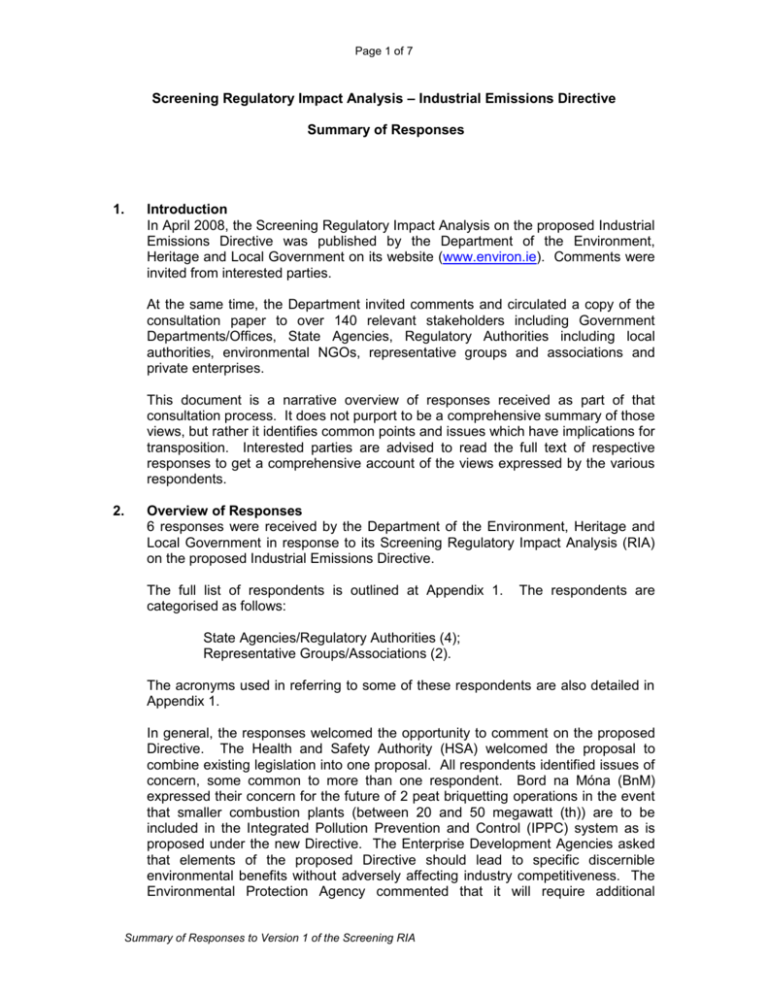
Page 1 of 7 Screening Regulatory Impact Analysis – Industrial Emissions Directive Summary of Responses 1. Introduction In April 2008, the Screening Regulatory Impact Analysis on the proposed Industrial Emissions Directive was published by the Department of the Environment, Heritage and Local Government on its website (www.environ.ie). Comments were invited from interested parties. At the same time, the Department invited comments and circulated a copy of the consultation paper to over 140 relevant stakeholders including Government Departments/Offices, State Agencies, Regulatory Authorities including local authorities, environmental NGOs, representative groups and associations and private enterprises. This document is a narrative overview of responses received as part of that consultation process. It does not purport to be a comprehensive summary of those views, but rather it identifies common points and issues which have implications for transposition. Interested parties are advised to read the full text of respective responses to get a comprehensive account of the views expressed by the various respondents. 2. Overview of Responses 6 responses were received by the Department of the Environment, Heritage and Local Government in response to its Screening Regulatory Impact Analysis (RIA) on the proposed Industrial Emissions Directive. The full list of respondents is outlined at Appendix 1. categorised as follows: The respondents are State Agencies/Regulatory Authorities (4); Representative Groups/Associations (2). The acronyms used in referring to some of these respondents are also detailed in Appendix 1. In general, the responses welcomed the opportunity to comment on the proposed Directive. The Health and Safety Authority (HSA) welcomed the proposal to combine existing legislation into one proposal. All respondents identified issues of concern, some common to more than one respondent. Bord na Móna (BnM) expressed their concern for the future of 2 peat briquetting operations in the event that smaller combustion plants (between 20 and 50 megawatt (th)) are to be included in the Integrated Pollution Prevention and Control (IPPC) system as is proposed under the new Directive. The Enterprise Development Agencies asked that elements of the proposed Directive should lead to specific discernible environmental benefits without adversely affecting industry competitiveness. The Environmental Protection Agency commented that it will require additional Summary of Responses to Version 1 of the Screening RIA Page 2 of 7 resources to deal with licensing a number of new activities proposed for licensing under the recast IPPC Directive. While the Irish Business Employers Confederation supports the overall objective of the proposed Directive, they believe that it is premature to recast the current IPPC Directive as it has yet to demonstrate its full potential in terms of emissions reductions and it is essential to have more experience before significant conclusions are drawn about its workability, consistency and efficiency. The Wood Marketing Federation (WMF) confined its comments to the inclusion of a new IPPC category on preservation of wood and wood products with a production capacity exceeding 75 m3 per day compared to the current threshold of 10 tonnes. 3. Summary of Analysis of Responses The responses submitted are presented below under broad headings, reflecting the implications of the proposed Directive discussed in the consultation paper. 4. Content of the RIA Main Amendments to the Existing Legislation – Appendix I to RIA Operators and Permits (Articles 4(2), 3(10), 5, 3(3)) The HSA is of the view that the proposed Directive should only permit two or more installations operated by the same operator if the environmental conditions are similar. The HSA asked what transitional arrangements would be put in place to assist existing installations to assist Member States ensure compliance with Article 4 of the proposed Directive which obliges Member States to ensure that no installation or combustion plant, waste incineration plant or waste co-incineration plant is operated without a permit. Best Available Techniques (BAT) The Enterprise Development Agencies consider the elements of flexibility in the present IPPC Directive as an important aspect of the Directive and consider that this flexibility has worked well to date. The Agencies are of the view that flexibility in the grant of installation permits and setting of Emission Limit Values (ELVs) and derogations from BAT reference documents (BREFs) is an important part of achieving a high level of environmental protection. Any change to this flexibility may lead to reduced efficiency. While the agencies consider the BREF documents as useful implementation tools their proposed more binding nature should not occur at the expense of this flexibility. IBEC shares this view and advises that the current Commission proposal to make BREFs more binding is not practical, undermines the principles of cooperation and consensus, and cannot be supported by industry. BATAELs-based permitting with a legally binding character and without enough consideration of local conditions would impose a massive cost burden on industry, in particular to small and medium sized enterprises and this could lead to production cuts rather than encouraging investment in cleaner technologies, and without a commensurate benefit for the environment as a whole. IBEC is of the view that Member States should be able to set ELVs that exceed values determined in relation to the BATAELs as described in the BREFs on the basis of an assessment of the environmental and economic costs and benefits taking into account the technical characteristics of the installation, its geographical Summary of Responses to Version 1 of the Screening RIA Page 3 of 7 location and the local environmental conditions. The HSA commented that consideration should be given to allowing more stringent emission limit values where such values would be required to protect man and the environment. The Enterprise Development Agencies consider that in terms of information exchange, stakeholders should have a central role to play in the selection of BATs and their corresponding emission levels and that information exchange should continue to be done on a collective and ongoing basis. The Agencies would prefer the current Seville process, which is based on consultation with all relevant stakeholders, to continue for producing BATs and ELVs rather than an increased use of comitology. IBEC is anxious that the current structured and continuous dialogue with stakeholders which they view as important for the IPPC Directive should not be disrupted. IBEC is of the view that if comitology is the route chosen by the European institutions, an explicit mechanism for consultation of stakeholders must be introduced in the proposal following the principles of better regulation and simplification and that, in addition, decisions taken by comitology committees should be made subject to an impact assessment. IBEC is opposed to any proposal that BAT would only be defined by the Commission. IBEC advised that this would not be acceptable to industry and that the Commission Technical Working Group comprising experts from various stakeholder groups, must continue to define BAT. IBEC is opposed to the proposal that when a new or updated BREF is adopted, Member States would, within four years of publication, where necessary, have to reconsider and update the general binding rules and permit conditions for the installations concerned. IBEC considers that the proposed time period of four years does not take into account the duration of investment cycles and service life of equipment and will therefore lead to legal uncertainty that will trigger disinvestments and possible plant closures and that this time period should be defined on a case-by-case basis. The EPA advised that Ireland has been an active participant in the Seville BREF process, and close regard had been to the BREF documents in the development of the National BAT Guidance Notes. The Agency further advised that the IPPC licences they grant are written with the current BAT in mind and appropriate ELVs and technological requirements are being faithfully observed in the licensing process. Compliance and Reporting Requirements The EPA commented that they have achieved a very high standard in the areas of compliance, enforcement and environmental improvements. All IPPC licences granted by the Agency carry a requirement for the putting in place of an Environmental Management System (EMS), of which continuous improvement is an integral part. The Agency has developed and deploys a Risk Based Assessment Methodology to determine the frequency of site inspections and audits and the likely risk of environmental impact is weighted into decision making on frequency of inspection. The Enterprise Development Agencies support a streamlining of the existing Directives dealing with industrial emissions with minimal substantive changes in terms of reporting requirements. The Agencies view the additional information Summary of Responses to Version 1 of the Screening RIA Page 4 of 7 obligations in Chapter I and II of the proposed Directive (for example those relating to the production of an annual compliance report or a soil status report) as matters of concern. The Enterprise Development Agencies advise that while it is important that small and medium sized enterprises adapt to environmental challenges, it is of equal importance that the compliance requirements of environmental legislation is proportionate to expected benefits for the environment. The EPA advised that they have no interest in adding to the administrative burden of those licensed under the IPPC regime or indeed operators liable to the provisions of other EU Directives. The Agency commented that where opportunities exist to cut the administrative burden on individual licensees as a result of streamlining the EU legislation, parallel reductions in the resource inputs by the Agency may also be possible. Soil Monitoring and Remediation (Articles 15, 17 and 23) IBEC questioned the rationale for introducing new soil and groundwater reporting and monitoring requirements and the obligation to return the site to an initial state defined in a baseline report. IBEC believes that very detailed descriptions of measures (baseline reports) jeopardise the subsidiarity principle. IPPC Activities (Chapters I, II, III & Annex I)) Bord na Móna (BnM) is opposed to the proposal in the Directive to include combustion installations between 20 and 50 megawatt within the scope of the IPPC licensing system. BnM operates two combustion plants both rated at a nominal 20 megawatt thermal input in order to provide the power and heat to facilitate peat briquetting at Derrinlough, Co. Offaly and Littleton, Co. Tipperary. BnM advises that the technology required to lower emissions to newer and more restricted levels is not readily available and consequently it would be extremely expensive to replace the boilers currently in use at these facilities. An unbearable burden on the economics of the peat briquetting operation where 250 people are employed would result from the inclusion of these combustion plants in the IPPC licensing system together with a resultant burden on the public who use this fuel. IBEC commented that considering small combustion plants and operators (including hospitals and universities) account for a fairly limited percentage of environmental impacts, the inclusion of such plants in the IPPC system would cause unnecessary bureaucratic burden and costs. The Enterprise Development Agencies commented that for smaller industrial activities which currently fall under the auspices of individual Directives and for which IPPC licences are inappropriate, the Commission must ensure that such entities remain similarly affected under the new proposals and that if this is not the case that exemptions should be sought for these activities. The Agencies are of the view that since 2007 existing installations have had to comply with the provisions of the IPPC Directive and that industry here is seen to be well on the path towards Best Available Techniques (BAT). The agencies would be keen to see that the amalgamation of the Directives should avoid going beyond their original scope. Summary of Responses to Version 1 of the Screening RIA Page 5 of 7 IBEC advised that they have always supported a streamlining of these Directives with minimal substantive changes only. IBEC are of the view that the proposed changes are far from being minimal since they constitute a complete change in the philosophy of the respective Directives and introduce new fundamental requirements such as lower Emission Limit Values (ELVs) or an extension of the scope of the legislation. IBEC proposes that the original ELVs, definitions, clarifications and guidance of the existing sectoral Directives should be maintained. WMF expressed concern at the current situation in the EU, whereby in Northern Ireland an IPPC licence or equivalent is not currently required if a water based preservative is used. The WMF estimate that water based preservatives are now used in 90% of the Republic’s wood treatment industry and given the current safe design and operation of timber treatment plants and the fact that certain substances are no longer in use in timber preservation, there is a strong argument to remove treatment plants from the IPPC licensing system operating in the Republic. The proposed Directive proposes to include the preservation of wood and wood products with a production capacity exceeding 75 m3 per day within the IPPC system. The WMF would welcome a level playing pitch throughout the EU in terms of preservative usage, environmental protection and competition. The WMF is seeking to have no volume threshold in the new IPPC category on preservation of wood and wood products throughout the EU. However, the WMF recognises that there may be valid reasons why the Commission would wish to retain a threshold. If these reasons are satisfactorily outlined, the WMF can support the proposal for the introduction of a production capacity threshold of 75 m3 per day, on the basis that the same procedure would apply throughout the EU. Other Miscellaneous Comments The HSA asked that the proposed Directive should define what is meant by significant pollution in Article 12 and also sought clarity as to whether odours are considered emissions within the definition of pollution. The HSA asked that a reference to the REACH Regulation be made within the proposed Directive. Under Article 62.5 (b) of REACH an applicant for an authorisation may include a justification for not considering risks to human health and the environment arising from an IPPC permitted facility. The HSA recommended that an IPPC permit application should outline (1) if substances listed in the candidate list of REACH are used as part of the activity and (2) consider the risk to man and the environment for substances listed in Annex XIV of the REACH Regulation that are used in the process. Costs The HSA commented that they are not in a position to determine the cost implications of the proposed Directive on Irish industrial activities and that consultation with current IPPC licensed facilities and other key stakeholders would be required to determine this impact. IBEC advised that the full extent of the cost implications for business will depend on the final negotiated text when the proposed Directive is adapted. The EPA advised that the changes suggested in Annex I of the proposed Directive which deals with IPPC activities will result in a number of new activities falling to be licensed under the recast Directive, over and above what was required under the IPPC Directive. The Agency advised that this will inevitably lead to additional Summary of Responses to Version 1 of the Screening RIA Page 6 of 7 resource requirements for the Agency in terms of licensing the ‘new’ licensable activities. 5. Conclusion Most respondents welcomed the opportunity to express their views on the consultation document and the proposed Directive. The comments submitted will be considered as part of the negotiations on the proposed Directive taking place at European level. It is hoped that, having engaged in this consultation process, it will assist in ensuring a greater understanding of the implications of the proposed Directive. The Screening RIA will be subject to further amendment and refinement in light of the final negotiated text when (and if) the Directive is adopted by the Environment Council and the European Parliament, and as part of the subsequent transposition of the adopted Directive into Irish law. Environment Policy Section 15 September, 2008 Summary of Responses to Version 1 of the Screening RIA Page 7 of 7 Appendix 1 List of Respondents The following are the list of those who submitted comments on the Screening Regulatory Impact Analysis on the proposed Industrial Emissions Directive. Acronyms Respondents BnM HSA IBEC EPA Bord na Móna Health and Safety Authority Irish Business and Employers Confederation Environmental Protection Agency Enterprise Development Agencies (Enterprise Ireland, Forfás and IDA Ireland) Wood Marketing Federation WMF The Department of Communications, Energy and Natural Resources, the Revenue Commissioners, the Department of Health and Children and the National Roads Authority also responded to the consultation paper but noted that they had no observations to offer. A copy of individual responses is available on request from: Environment Policy Section, Department of the Environment, Heritage and Local Government, Ardcavan Business Park, Ardcavan, Wexford. (email: environmentpolicy@environ.ie) Summary of Responses to Version 1 of the Screening RIA
